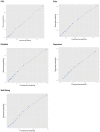Development and validation of a prediction model of poor performance status and severe symptoms over time in cancer patients (PROVIEW+)
- PMID: 34128429
- PMCID: PMC8532207
- DOI: 10.1177/02692163211019302
Development and validation of a prediction model of poor performance status and severe symptoms over time in cancer patients (PROVIEW+)
Abstract
Background: Predictive cancer tools focus on survival; none predict severe symptoms.
Aim: To develop and validate a model that predicts the risk for having low performance status and severe symptoms in cancer patients.
Design: Retrospective, population-based, predictive study.
Setting/participants: We linked administrative data from cancer patients from 2008 to 2015 in Ontario, Canada. Patients were randomly selected for model derivation (60%) and validation (40%). Using the derivation cohort, we developed a multivariable logistic regression model to predict the risk of an outcome at 6 months following diagnosis and recalculated after each of four annual survivor marks. Model performance was assessed using discrimination and calibration plots. Outcomes included low performance status (i.e. 10-30 on Palliative Performance Scale), severe pain, dyspnea, well-being, and depression (i.e. 7-10 on Edmonton Symptom Assessment System).
Results: We identified 255,494 cancer patients (57% female; median age of 64; common cancers were breast (24%); and lung (13%)). At diagnosis, the predicted risk of having low performance status, severe pain, well-being, dyspnea, and depression in 6-months is 1%, 3%, 6%, 13%, and 4%, respectively for the reference case (i.e. male, lung cancer, stage I, no symptoms); the corresponding discrimination for each outcome model had high AUCs of 0.807, 0.713, 0.709, 0.790, and 0.723, respectively. Generally these covariates increased the outcome risk by >10% across all models: lung disease, dementia, diabetes; radiation treatment; hospital admission; pain; depression; transitional performance status; issues with appetite; or homecare.
Conclusions: The model accurately predicted changing cancer risk for low performance status and severe symptoms over time.
Keywords: ADL; Cancer; depression; dyspnea; logistic model; pain; palliative care; prognosis.
Conflict of interest statement
Figures
Similar articles
-
Artificial neural networks for simultaneously predicting the risk of multiple co-occurring symptoms among patients with cancer.Cancer Med. 2021 Feb;10(3):989-998. doi: 10.1002/cam4.3685. Epub 2020 Dec 22. Cancer Med. 2021. PMID: 33350595 Free PMC article.
-
Development and Validation of a Prognostic Survival Model With Patient-Reported Outcomes for Patients With Cancer.JAMA Netw Open. 2020 Apr 1;3(4):e201768. doi: 10.1001/jamanetworkopen.2020.1768. JAMA Netw Open. 2020. PMID: 32236529 Free PMC article.
-
Development and Validation of a Survival Prediction Model for Patients With Pancreatic Cancer.Clin Transl Gastroenterol. 2025 Jan 1;16(1):e00774. doi: 10.14309/ctg.0000000000000774. Clin Transl Gastroenterol. 2025. PMID: 39620578 Free PMC article.
-
Telephone interventions for symptom management in adults with cancer.Cochrane Database Syst Rev. 2020 Jun 2;6(6):CD007568. doi: 10.1002/14651858.CD007568.pub2. Cochrane Database Syst Rev. 2020. PMID: 32483832 Free PMC article.
-
Performance of prediction models for nephropathy in people with type 2 diabetes: systematic review and external validation study.BMJ. 2021 Sep 28;374:n2134. doi: 10.1136/bmj.n2134. BMJ. 2021. PMID: 34583929 Free PMC article.
Cited by
-
Development and validation of hybrid machine learning approach for predicting survival in patients with cervical cancer: a SEER-based population study.Front Oncol. 2025 Jun 18;15:1605378. doi: 10.3389/fonc.2025.1605378. eCollection 2025. Front Oncol. 2025. PMID: 40606977 Free PMC article.
-
Artificial neural networks for simultaneously predicting the risk of multiple co-occurring symptoms among patients with cancer.Cancer Med. 2021 Feb;10(3):989-998. doi: 10.1002/cam4.3685. Epub 2020 Dec 22. Cancer Med. 2021. PMID: 33350595 Free PMC article.
-
Postoperative Karnofsky performance status prediction in patients with IDH wild-type glioblastoma: A multimodal approach integrating clinical and deep imaging features.PLoS One. 2024 Nov 11;19(11):e0303002. doi: 10.1371/journal.pone.0303002. eCollection 2024. PLoS One. 2024. PMID: 39527541 Free PMC article.
-
Using real-world electronic health record data to predict the development of 12 cancer-related symptoms in the context of multimorbidity.JAMIA Open. 2024 Sep 12;7(3):ooae082. doi: 10.1093/jamiaopen/ooae082. eCollection 2024 Oct. JAMIA Open. 2024. PMID: 39282082 Free PMC article.
-
Physician home visits in Ontario: a cross-sectional analysis of patient characteristics and postvisit use of health care services.CMAJ Open. 2022 Aug 9;10(3):E732-E745. doi: 10.9778/cmajo.20210307. Print 2022 Jul-Sep. CMAJ Open. 2022. PMID: 35944922 Free PMC article.
References
-
- Zimmermann C, Swami N, Krzyzanowska M, et al.. Early palliative care for patients with advanced cancer: a cluster-randomised controlled trial. Lancet 2014; 383(9930): 1721–1730. - PubMed
-
- Temel JS, Greer JA, Muzikansky A, et al.. Early palliative care for patients with metastatic non-small-cell lung cancer. N Engl J Med 2010; 363(8): 733–742. - PubMed
-
- Ferrell BR, Temel JS, Temin S, et al.. Integration of palliative care into standard oncology care: ASCO clinical practice guideline update summary. J Oncol Pract 2017; 13(2): 119–121. - PubMed
-
- National Hospice and Palliative Care Organization. NHPCO facts and figures: hospice care in America. Alexandria, V: National Hospice and Palliative Care Organization, 2016.
MeSH terms
LinkOut - more resources
Full Text Sources
Medical


